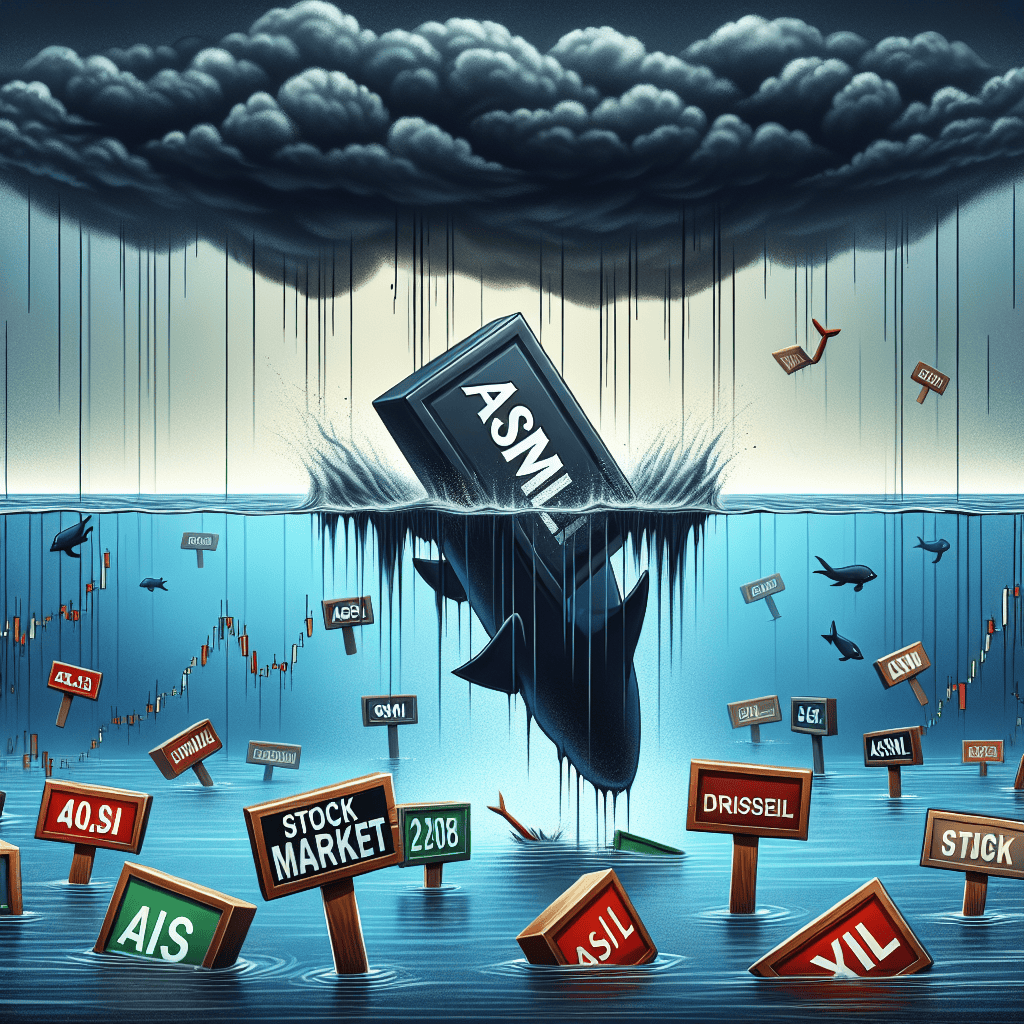“ASML’s Early Reveal: A Glimpse of Gloom in the Chip Giant’s Horizon”
Introduction
ASML Holding NV, a leading supplier in the semiconductor industry, recently experienced a significant decline in its stock value following the release of its financial results ahead of schedule. The early disclosure revealed a weaker-than-anticipated outlook, sparking concerns among investors and analysts. ASML, known for its advanced lithography machines essential for chip manufacturing, has been a bellwether for the tech sector. However, the latest results have raised questions about the company’s future growth prospects amid a challenging market environment. The unexpected timing and the nature of the outlook have contributed to heightened market volatility, reflecting broader uncertainties in the semiconductor industry.
Analysis Of ASML’s Early Financial Results And Market Reaction
ASML Holding NV, a pivotal player in the semiconductor industry, recently released its financial results earlier than anticipated, sending ripples through the market. The company’s stock experienced a significant decline following the announcement, primarily due to a weaker-than-expected outlook that caught investors off guard. This unexpected release and the subsequent market reaction warrant a closer examination of the factors at play and the broader implications for both ASML and the semiconductor sector.
To begin with, ASML’s early disclosure of its financial results was an unusual move, raising questions about the motivations behind this decision. Typically, companies adhere to a predetermined schedule for releasing earnings reports, allowing investors to prepare and adjust their expectations accordingly. However, ASML’s deviation from this norm suggests an urgency to address market conditions or internal developments that could not wait for the scheduled announcement. This urgency, in turn, may have contributed to the heightened market sensitivity and the subsequent stock decline.
The core of the market’s reaction lies in ASML’s outlook, which was notably weaker than analysts and investors had anticipated. Despite reporting solid revenue figures for the quarter, the company’s forward-looking statements painted a less optimistic picture. This discrepancy between current performance and future expectations is crucial, as it underscores the challenges ASML faces in maintaining its growth trajectory amid a rapidly evolving semiconductor landscape. Factors such as supply chain disruptions, geopolitical tensions, and fluctuating demand for semiconductor equipment have all played a role in shaping this outlook.
Moreover, ASML’s position as a leader in the production of photolithography machines, essential for semiconductor manufacturing, means that its performance is closely tied to the health of the broader industry. The semiconductor sector has been experiencing a period of volatility, driven by both cyclical and structural changes. On one hand, the cyclical nature of the industry means that periods of high demand are often followed by downturns, as seen in the recent global chip shortage. On the other hand, structural shifts, such as the push for technological advancements and the transition to more advanced manufacturing processes, add layers of complexity to the market dynamics.
In light of these challenges, ASML’s cautious outlook reflects a prudent approach to navigating the uncertainties ahead. The company must balance its investments in research and development with the need to manage costs and maintain profitability. This balancing act is further complicated by the competitive pressures from other players in the semiconductor equipment market, who are also vying for a share of the growing demand for advanced manufacturing technologies.
The market’s reaction to ASML’s early results serves as a reminder of the delicate interplay between investor expectations and corporate performance. While the immediate stock decline may seem concerning, it is essential to consider the long-term prospects of the company and the industry as a whole. ASML’s technological leadership and strategic initiatives position it well to capitalize on future opportunities, provided it can effectively address the challenges outlined in its outlook.
In conclusion, ASML’s unexpectedly early financial results and the accompanying weak outlook have prompted a reevaluation of its market position and future prospects. The stock’s decline highlights the sensitivity of investors to shifts in expectations, particularly in an industry as dynamic as semiconductors. As ASML navigates this complex landscape, its ability to adapt and innovate will be crucial in determining its trajectory in the coming years.
Factors Contributing To ASML’s Weak Outlook
ASML Holding NV, a pivotal player in the semiconductor industry, recently released its financial results earlier than anticipated, causing a significant stir in the market. The company’s stock experienced a notable decline following the announcement, primarily due to a weaker-than-expected outlook. Several factors have contributed to this subdued forecast, each playing a crucial role in shaping investor sentiment and market reactions.
To begin with, the global semiconductor industry is currently navigating a period of uncertainty. While demand for semiconductors remains robust, driven by advancements in technology and the proliferation of electronic devices, supply chain disruptions continue to pose significant challenges. These disruptions, exacerbated by geopolitical tensions and the lingering effects of the COVID-19 pandemic, have led to delays in production and delivery schedules. Consequently, companies like ASML, which are integral to the semiconductor supply chain, are facing difficulties in meeting demand, thereby impacting their financial projections.
Moreover, ASML’s outlook has been further dampened by the cyclical nature of the semiconductor industry. Historically, this sector has experienced periods of rapid growth followed by phases of contraction. Currently, the industry appears to be entering a phase of moderation after a period of unprecedented expansion. This cyclical downturn is reflected in ASML’s cautious guidance, as the company anticipates a slowdown in orders from key customers who are adjusting their inventories in response to changing market conditions.
In addition to these industry-wide challenges, ASML is also contending with company-specific issues. The firm has been investing heavily in research and development to maintain its competitive edge, particularly in the field of extreme ultraviolet (EUV) lithography technology. While these investments are crucial for long-term growth, they have also led to increased operational costs in the short term. This rise in expenses, coupled with the aforementioned supply chain issues, has put pressure on ASML’s profit margins, contributing to the weaker outlook.
Furthermore, regulatory and geopolitical factors are also influencing ASML’s prospects. The semiconductor industry is highly sensitive to international trade policies and regulations, which can affect the flow of goods and services across borders. Recent developments, such as trade tensions between major economies and stricter export controls, have created an environment of uncertainty. For ASML, which relies on a global customer base, these geopolitical dynamics pose potential risks to its business operations and revenue streams.
Despite these challenges, it is important to note that ASML remains a leader in its field, with a strong track record of innovation and a solid customer base. The company’s advanced lithography machines are essential for producing cutting-edge semiconductors, and its technological prowess continues to be a significant competitive advantage. However, in the short term, the combination of supply chain disruptions, cyclical industry trends, increased operational costs, and geopolitical uncertainties has led to a more cautious outlook.
In conclusion, ASML’s unexpectedly early financial results have highlighted several factors contributing to its weak outlook. While the company is navigating a complex landscape marked by industry-wide and company-specific challenges, its long-term prospects remain promising. Investors and stakeholders will be closely monitoring how ASML addresses these issues and adapts to the evolving market conditions in the coming months. As the semiconductor industry continues to evolve, ASML’s ability to innovate and maintain its leadership position will be critical to its future success.
Impact Of ASML’s Performance On The Semiconductor Industry
ASML Holding NV, a pivotal player in the semiconductor industry, recently released its financial results earlier than anticipated, sending ripples through the market. The company’s stock took a significant hit following the announcement, primarily due to a weaker-than-expected outlook. This development has raised concerns about the broader implications for the semiconductor industry, which relies heavily on ASML’s advanced lithography equipment for chip manufacturing.
ASML’s performance is often seen as a bellwether for the semiconductor sector, given its critical role in supplying the machines that enable the production of cutting-edge chips. The company’s unexpected results have therefore sparked a wave of uncertainty among investors and industry stakeholders. The weaker outlook suggests potential challenges in the demand for semiconductor equipment, which could have far-reaching consequences for the entire supply chain.
The semiconductor industry has been navigating a complex landscape marked by fluctuating demand, geopolitical tensions, and supply chain disruptions. ASML’s recent announcement adds another layer of complexity, as it may signal a slowdown in the industry’s growth trajectory. This is particularly concerning given the industry’s pivotal role in powering a wide array of technologies, from consumer electronics to advanced computing systems.
Moreover, ASML’s results come at a time when the semiconductor industry is grappling with a global chip shortage. This shortage has underscored the critical importance of semiconductor manufacturing capacity and the need for continued investment in advanced technologies. ASML’s lithography machines are essential for producing the most advanced chips, and any indication of reduced demand for these machines could exacerbate existing supply chain challenges.
In addition to supply chain concerns, ASML’s outlook may also reflect broader economic uncertainties. The semiconductor industry is highly sensitive to macroeconomic factors, including consumer spending patterns and global trade dynamics. A weaker outlook from ASML could suggest that these factors are beginning to weigh on the industry’s growth prospects, potentially leading to a reassessment of investment strategies by semiconductor companies.
Furthermore, ASML’s performance could have implications for technological innovation within the semiconductor industry. The company’s lithography machines are at the heart of efforts to produce smaller, more powerful chips, which are crucial for advancing technologies such as artificial intelligence, 5G, and autonomous vehicles. A slowdown in ASML’s growth could hinder the pace of innovation, affecting the development of these transformative technologies.
Despite these challenges, it is important to recognize that the semiconductor industry has demonstrated resilience in the face of adversity. Companies within the sector have consistently adapted to changing market conditions, leveraging technological advancements to drive growth. While ASML’s recent results may signal a period of uncertainty, the industry’s long-term prospects remain promising, driven by the increasing demand for semiconductors across various applications.
In conclusion, ASML’s unexpectedly early results and weak outlook have cast a shadow over the semiconductor industry, raising concerns about potential challenges in demand and supply chain dynamics. However, the industry’s inherent resilience and capacity for innovation provide a foundation for navigating these uncertainties. As stakeholders assess the implications of ASML’s performance, the focus will likely remain on strategic investments and technological advancements to sustain growth in this critical sector.
Investor Sentiment And ASML’s Stock Volatility

ASML Holding NV, a pivotal player in the semiconductor industry, recently experienced a significant drop in its stock value following the release of its financial results earlier than anticipated. The unexpected timing of this announcement caught investors off guard, leading to heightened scrutiny of the company’s performance and future prospects. The results, which included a weaker-than-expected outlook, have sparked a wave of concern among investors, contributing to the stock’s volatility.
The semiconductor industry, known for its cyclical nature, has been under pressure due to fluctuating demand and supply chain disruptions. ASML, as a leading supplier of photolithography machines essential for chip manufacturing, is often seen as a bellwether for the sector. Therefore, any indication of a slowdown in its business can have a ripple effect across the industry. The company’s early release of its financial results, coupled with a cautious outlook, has amplified these concerns, leading to a sharp decline in investor confidence.
Investor sentiment plays a crucial role in the stock market, often driving price movements based on perceptions rather than fundamentals. In the case of ASML, the unexpectedly early results have led to a reassessment of the company’s growth trajectory. While ASML has consistently demonstrated strong performance in the past, the current outlook suggests potential headwinds that could impact its future earnings. This has prompted investors to reevaluate their positions, leading to increased selling pressure on the stock.
Moreover, the broader economic environment has also contributed to ASML’s stock volatility. With ongoing geopolitical tensions and economic uncertainties, investors are becoming increasingly risk-averse. The semiconductor industry, being highly sensitive to global economic shifts, is particularly vulnerable to these external factors. ASML’s cautious outlook, therefore, resonates with broader market concerns, further exacerbating the stock’s decline.
Transitioning to the company’s strategic initiatives, ASML has been investing heavily in research and development to maintain its competitive edge. The company is at the forefront of developing advanced lithography technologies, which are critical for producing next-generation semiconductors. However, the substantial capital expenditure required for these innovations can strain financial resources, especially in a challenging economic climate. This dual focus on innovation and financial prudence is a delicate balance that ASML must navigate to reassure investors of its long-term viability.
In light of these developments, analysts are closely monitoring ASML’s ability to adapt to changing market dynamics. The company’s leadership has emphasized its commitment to addressing supply chain challenges and meeting customer demand. However, the effectiveness of these measures remains to be seen, as the semiconductor industry continues to grapple with unprecedented challenges.
In conclusion, ASML’s recent stock volatility underscores the complex interplay between investor sentiment and market realities. The unexpectedly early release of its financial results, coupled with a weak outlook, has raised questions about the company’s future performance. As ASML navigates this turbulent period, its ability to manage external pressures and execute its strategic initiatives will be critical in restoring investor confidence. While the road ahead may be fraught with challenges, ASML’s track record of innovation and resilience provides a foundation for potential recovery. Investors, therefore, will be keenly watching the company’s next moves, as they weigh the risks and opportunities in this dynamic industry.
Long-term Implications Of ASML’s Current Financial Challenges
ASML Holding NV, a pivotal player in the semiconductor industry, recently released its financial results earlier than anticipated, sending ripples through the market as its stock experienced a significant decline. The unexpected timing of the announcement was compounded by a weaker-than-expected outlook, raising concerns among investors and analysts alike. This development prompts a closer examination of the long-term implications of ASML’s current financial challenges, particularly in the context of the broader semiconductor sector.
To begin with, ASML’s role as a leading supplier of photolithography machines, which are essential for producing advanced microchips, places it at the heart of the semiconductor supply chain. The company’s technology is crucial for the production of smaller, more powerful, and energy-efficient chips, which are in high demand across various industries, from consumer electronics to automotive and telecommunications. Therefore, any financial instability within ASML could have far-reaching consequences, potentially affecting the entire semiconductor ecosystem.
The weaker outlook presented by ASML can be attributed to several factors, including fluctuating demand in the semiconductor market and geopolitical tensions that have disrupted global supply chains. The semiconductor industry has been grappling with a cyclical downturn, characterized by inventory corrections and reduced capital expenditures by major chip manufacturers. This cyclical nature of the industry means that companies like ASML must navigate periods of both rapid growth and contraction, requiring strategic agility and foresight.
Moreover, geopolitical tensions, particularly between the United States and China, have introduced additional layers of complexity. Trade restrictions and export controls have impacted the flow of semiconductor technology and equipment, creating uncertainty for companies operating in this space. ASML, with its significant exposure to the Chinese market, faces challenges in balancing compliance with international regulations while maintaining its competitive edge.
In light of these challenges, ASML’s management must focus on long-term strategies to mitigate risks and sustain growth. One potential avenue is the continued investment in research and development to maintain technological leadership. By advancing its extreme ultraviolet (EUV) lithography technology, ASML can ensure that it remains indispensable to chipmakers seeking to push the boundaries of Moore’s Law. Additionally, diversifying its customer base and expanding into emerging markets could provide a buffer against regional disruptions.
Furthermore, ASML’s financial challenges underscore the importance of collaboration within the semiconductor industry. Partnerships with chip manufacturers, governments, and research institutions can foster innovation and resilience. By working together, stakeholders can address supply chain vulnerabilities and develop solutions to meet the evolving demands of the digital economy.
In conclusion, while ASML’s unexpectedly early financial results and weak outlook have raised concerns, it is essential to view these challenges within the broader context of the semiconductor industry’s cyclical nature and geopolitical dynamics. The company’s ability to navigate these complexities will determine its long-term success and influence on the global technology landscape. By focusing on innovation, diversification, and collaboration, ASML can position itself to weather current challenges and capitalize on future opportunities, ultimately reinforcing its role as a cornerstone of the semiconductor sector. As the industry continues to evolve, ASML’s strategic decisions will not only impact its own trajectory but also shape the future of technology worldwide.
Comparison Of ASML’s Performance With Competitors
ASML Holding NV, a pivotal player in the semiconductor industry, recently experienced a significant decline in its stock value following the release of its quarterly results, which were disclosed earlier than anticipated. The company’s financial outlook, which fell short of market expectations, has raised concerns among investors and analysts alike. This development prompts a closer examination of ASML’s performance in comparison to its competitors, shedding light on the broader implications for the semiconductor sector.
ASML, renowned for its cutting-edge lithography machines essential for producing advanced microchips, has long been considered a bellwether for the semiconductor industry. Its technology is crucial for the production of smaller, more efficient chips, which are in high demand across various sectors, including consumer electronics, automotive, and telecommunications. Despite its technological prowess, ASML’s recent financial results have highlighted vulnerabilities that have not gone unnoticed by market participants.
In contrast to ASML’s recent struggles, some of its competitors have managed to navigate the challenging market conditions more effectively. For instance, companies like Applied Materials and Lam Research have reported relatively stable performances, buoyed by their diversified product portfolios and strategic positioning within the semiconductor supply chain. These firms have capitalized on the growing demand for semiconductor equipment, driven by the global push towards digitalization and the proliferation of connected devices.
Moreover, Taiwan Semiconductor Manufacturing Company (TSMC), a key customer of ASML, has continued to demonstrate robust growth, further underscoring the competitive landscape in which ASML operates. TSMC’s ability to maintain its leadership position in the foundry market, coupled with its strategic investments in advanced manufacturing technologies, has allowed it to weather the cyclical nature of the semiconductor industry more effectively than some of its peers.
While ASML’s technological edge remains undisputed, its recent financial performance has highlighted the challenges it faces in maintaining its competitive advantage. The company’s reliance on a limited number of high-value customers, such as TSMC and Samsung, exposes it to fluctuations in demand and shifts in customer priorities. This dependency underscores the importance of diversifying its customer base and exploring new growth avenues to mitigate potential risks.
Furthermore, the semiconductor industry is characterized by rapid technological advancements and intense competition, necessitating continuous innovation and investment in research and development. ASML’s commitment to innovation is evident in its ongoing efforts to develop next-generation lithography technologies, such as extreme ultraviolet (EUV) lithography. However, the substantial capital expenditure required for such advancements poses a challenge, particularly in an environment of economic uncertainty and tightening financial conditions.
In conclusion, ASML’s recent stock decline serves as a reminder of the inherent volatility and competitive pressures within the semiconductor industry. While the company remains a technological leader, its financial outlook has raised questions about its ability to sustain its growth trajectory amidst evolving market dynamics. By comparing ASML’s performance with that of its competitors, it becomes clear that strategic diversification, customer relationship management, and continued innovation are crucial for maintaining a competitive edge. As the semiconductor industry continues to evolve, ASML’s ability to adapt and respond to these challenges will be pivotal in determining its future success.
Strategies For Investors In Light Of ASML’s Recent Results
ASML Holding NV, a pivotal player in the semiconductor industry, recently released its financial results earlier than anticipated, causing a significant stir in the market. The company’s stock took a notable hit following the announcement, primarily due to a weaker-than-expected outlook. This development has left investors pondering their next moves, as ASML’s performance is often seen as a bellwether for the broader technology sector. In light of these recent results, investors must carefully consider their strategies to navigate the potential volatility and capitalize on future opportunities.
To begin with, it is essential for investors to understand the underlying reasons behind ASML’s subdued outlook. The company cited a slowdown in demand for its advanced lithography machines, which are crucial for producing cutting-edge semiconductors. This deceleration is largely attributed to macroeconomic uncertainties and a potential oversupply in the semiconductor market. Consequently, investors should closely monitor global economic indicators and industry trends to assess whether this downturn is a temporary blip or indicative of a more prolonged challenge.
In response to ASML’s current situation, diversification emerges as a prudent strategy for investors. By spreading investments across various sectors and asset classes, investors can mitigate the risks associated with a single company’s performance. While ASML remains a dominant force in the semiconductor industry, its recent results underscore the importance of not placing all eggs in one basket. Diversification can help investors cushion the impact of ASML’s stock fluctuations and provide exposure to other growth opportunities.
Moreover, investors should consider the long-term potential of ASML despite its short-term challenges. The company’s technological prowess and market leadership position it well for future growth, particularly as demand for semiconductors is expected to rebound in the coming years. As industries such as artificial intelligence, 5G, and electric vehicles continue to expand, the need for advanced semiconductors will likely increase. Therefore, investors with a long-term horizon may view the current dip in ASML’s stock as a buying opportunity, provided they have confidence in the company’s ability to navigate the current headwinds.
Additionally, staying informed about ASML’s strategic initiatives and developments is crucial for investors. The company is known for its innovation and commitment to research and development, which are key drivers of its competitive advantage. By keeping abreast of ASML’s technological advancements and market strategies, investors can make more informed decisions about their investment positions. This knowledge can also help investors identify potential catalysts that could drive ASML’s stock recovery in the future.
Furthermore, it is advisable for investors to maintain a disciplined approach to risk management. Setting clear investment goals and establishing stop-loss orders can help protect against significant losses in the event of further declines in ASML’s stock price. By adhering to a well-defined risk management strategy, investors can navigate the current uncertainty with greater confidence and resilience.
In conclusion, ASML’s unexpectedly early results and weak outlook have undoubtedly raised concerns among investors. However, by adopting a diversified investment strategy, focusing on long-term potential, staying informed about the company’s developments, and maintaining disciplined risk management, investors can position themselves to weather the current challenges and potentially benefit from future opportunities in the semiconductor industry. As always, careful analysis and strategic planning remain essential components of successful investing.
Q&A
1. **What caused ASML’s stock to tank?**
ASML’s stock tanked due to the release of unexpectedly early results that included a weak outlook for future performance.
2. **What were the key financial metrics reported by ASML?**
The key financial metrics included lower-than-expected revenue and profit forecasts, which disappointed investors.
3. **How did the market react to ASML’s early results?**
The market reacted negatively, leading to a significant drop in ASML’s stock price.
4. **What specific outlook did ASML provide that was considered weak?**
ASML provided a weak outlook regarding future demand for its semiconductor manufacturing equipment, citing potential slowdowns in the industry.
5. **Did ASML mention any external factors affecting its performance?**
Yes, ASML mentioned factors such as global economic uncertainties and potential slowdowns in the semiconductor industry.
6. **How did analysts respond to ASML’s early results and outlook?**
Analysts responded by downgrading the stock and adjusting their price targets, reflecting concerns over the company’s future growth prospects.
7. **What are the potential implications for the semiconductor industry following ASML’s announcement?**
The potential implications include concerns about a broader slowdown in semiconductor demand, which could affect other companies in the industry.
Conclusion
ASML’s stock decline following the release of its unexpectedly early results, which included a weak outlook, highlights investor concerns about the company’s future performance. The weak outlook may suggest potential challenges in demand, supply chain issues, or competitive pressures that could impact ASML’s growth trajectory. This reaction underscores the sensitivity of the market to forward-looking statements and the importance of meeting or exceeding investor expectations. The stock’s performance may continue to be volatile as stakeholders assess the company’s ability to navigate these challenges and deliver on its strategic objectives.





